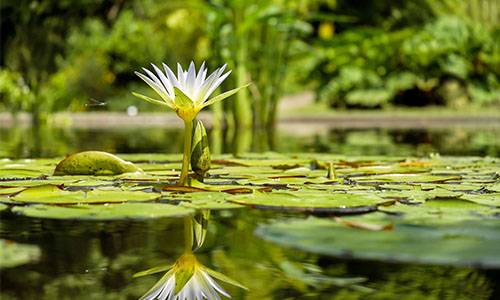

Which plants that can grow in water? Which ones would you like? Water plants don’t need a watering can.
Small, fresh-smelling plants indoors, but of course they need sunlight too! Let’s take a look at 7 plants that can be grown in the water!
1. OREGANO
Oregano is a perennial herb of the genus Oregano in the family Labiatae. Oregano is pungent, cool, non-toxic, and the whole herb can be used as a medicine to clear heat and relieve symptoms, relieve dampness and urination, and reduce swelling.
It is used clinically for the prevention of influenza and treatment of gangrene, heatstroke, fever, vomiting, acute gastroenteritis, abdominal pain, etc. It is better than mint in dispersing cold and relieving symptoms. Oregano contains more than 30 antibacterial compounds and is a potent natural antibiotic and pharmaceutical growth promoter.
Oregano is a great plant that can be propagated hydroponically, but of course, hydroponics is also possible, cut off a section, remove the lower leaves, you can soak in water to grow roots, grow up to add nutrient solution regularly to do so.
2. BASIL
Basil is a medicinal and food aromatic plant, tastes like fennel, the whole plant is small, bright green leaves, bright flowers, fragrant. It is very sensitive to cold and grows best in hot and dry environments. With a powerful, stimulating, fragrant odor, some are perennial plants. Some make beautiful bonsai with a little pruning and can be grown in pots for ornamental purposes.
Basil is an essential herb in the kitchen, often used as a seasoning herb plant, its leaves are very shiny, it is also easy to propagate herbs, cut a section can be propagated, any like it?
3. SAGE
Sage (scientific name: Salvia japonica Thunb.), also known as medicinal sage, Salvia, Japanese purple sage, southern tansy, also known as stone see-through, is an aromatic plant of the genus Salvia in the family Labiatae. It is a small evergreen subshrub with woody stems, gray-green leaves, and blue to blue-purple flowers.
It is often cultivated as a kitchen herb or medical herb and is sometimes called garden sage, kitchen sage, and Dalmatian sage. In parts of Europe, especially in the Balkans, sage is planted to extract essential oils.
There are so many varieties of sage, not every kind is suitable for hydroponics Oh, seedlings hydroponics growth is very good, but after growing up, it is easy to be bound by the hydroponic container, to change the pot in time, it still looks pretty good!
4. THYME
Thyme (scientific name: Thymus mongolicus Ronn), semi-shrub, leaves are ovoid, inflorescence capitate, corolla purple-red, purple or light purple, pink, flowering July-August, nutlets suborbicular or ovoid. It can be used as an ingredient, a common spice in European cooking, with a pungent flavor, used to add to stews, eggs, or soups.
Thyme was traditionally considered to symbolize courage in Europe, so it was often used in the Middle Ages to give to knights on expeditions. Known in China as ground pepper, ground pepper, mountain pepper, mountain pepper, and musk herb, thyme is native to southern Europe and is widely grown as a gourmet spice.
Thyme smell quite good, the leaves look fresh and light, grow lush, they are also like a warm and moist environment, hydroponics, pay attention to diffused light and ventilation.
5. ROSEMARY
Rosemary, the Latin name (Rosmarinus officinalis) Labiatae shrub.
Sex like a warm climate, from the flowers and leaves of rosemary, can be extracted with excellent antioxidant properties of antioxidants and rosemary essential oil.
Rosemary antioxidants. Widely used in medicine, fried food, oil-rich food, and all kinds of fats and oils to preserve freshness and quality; and rosemary essential oil is used in fragrances, air fresheners, and repellents, and sterilization, insecticides, and other daily chemical industry.
When it comes to rosemary, it reminds me of its taste, really good yeah, smell also want, it is very windowsill good herb small potted plants, try hydroponics and why not?
6. STEVIA
Stevia is a perennial herb of the family Asteraceae, Stevia. The stem is erect, the basal tip is woody, the upper part is tender, densely short velvet, the corolla is light purple-red or white at the base, the upper part is white. Fl. July-September, fr. September-November. Prefers to grow in a warm and humid environment, light-sensitive.
The leaves contain 6-12% inulin, and the fine product is in the form of white powder, which is a low-calorie, high-sweet natural sweetener and one of the raw materials for food and pharmaceutical industries.
Its leaves are naturally sweet, but raw will be a bit astringent, it can even replace sugar, so its taste will not have to question how, the key is to learn how to raise good!
7. MINT
Mint, the native name of “Yin Dan grass”, for the Labiatae, that is, the same genus of other dry whole grass. Is a special economic value of aromatic crops. The whole plant is green and aromatic. The leaves are opposite, the flowers are small lavender, lip-shaped, and bear small dark purple-brown fruits after flowering.
Mint is one of the common Chinese herbs. It is a pungent, cooling, sweating, and antipyretic herb that treats influenza, headache, red eyes, body heat, sore throat, and swollen teeth. It can be used externally to treat neuralgia, itchy skin, rashes, and eczema. Usually, mint is used as a tea substitute to clear the mind and eyes.
Mint is not only used to make tea, or a fragrant potted plant, just think of the word mint, you can think of a whole lot of other items, it has so many uses, I just want a pot of hydroponic potted plant! Water plug mint, a day and a half rooted, two days to grow new leaves, too easy to grow, but the follow-up to add nutrient solution, or soon yellow leaves, after the regular addition, no five days to drop three drops, but also see the diffused light Oh!

